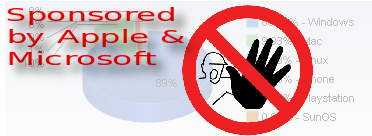05.14.09
Links 14/05/2009: Ubuntu 9.10 Alpha; Solar-powered Sub-notebooks Run GNU/Linux
![]()
Contents
GNU/Linux
-
Audio
-
Linux Outlaws 91 – Outlaws Don’t Accept the CoC
This week on the show: Ubuntu One, more ATI pain, Sony wants to go more open, Windows 7 RCs will be crippled, lots of announcements and Fab reviews the Ubuntu Netbook Remix.
-
[Tux radar] Podcast Season 1 Episode 8
In this episode: OpenOffice.org 3.1 is out and we take a guess at just how many lines of source code it has, Glibc has been forked, a ZDNet report whose name we can’t pronounce takes a potshot at Moonlight, and our Open Ballot asks whether we need a standard package manager.
-
Finally, A Creative X-Fi Driver Going Into ALSA
While this has been a long and dirty mess, the good news is that as of today there is a merge-able version of the Creative X-Fi driver for ALSA. Novell’s Takashi Iwai who wrote the original X-Fi driver has managed to get in contact with Creative Labs to create this genuine X-Fi ALSA driver, which is in far better condition than his previous hack-ish attempt. This new Sound Blaster X-Fi driver is called snd-ctxfi and more information on it can be found within the ALSA development list.
-
-
Events
-
Grodno to host Linux Vacation/Eastern Europe 2009 International Conference
Grodno will host the international conference of free software developers Linux Vacation/Eastern Europe 2009, Gleb Rubanov, one of the organizers of the event, told BelTA.
-
Penguicon 2009
This year I went to a convention known as Penguicon. It is a convention where you can dress up as your favorite anime/Star Wars/ or whatever you want to dress up as…if at all. I choose the scariest costume that I can muster. ME. Ok stop running for that window, get back in your chair and read on.
-
-
Interviews
-
Interview with Tristan Nitot, president of Mozilla Europe
We have the opportunity to interview Tristan Nitot (in italiano su Webnews), president of Mozilla Europe. Tristan speaks about the relashionship between Mozilla and Google, Chrome and the future of Firefox on mobile platforms.
-
Interview with Greg Dekoenigsberg – Red Hat Community Architect
The Fedora 10 CDs and DVDs came in at half the price, and were of far better quality, and were shipped around the country more cheaply, and the process was just way better.
Why was this so? Simple. The “leaders” of a project can be overwhelmed with mundane tasks, and with so much to get done, some tasks just get pushed to the back burner. But if you can find the right volunteer, and if you say to that volunteer “this is your task, and I’m counting on you to do it better than I did,” that task becomes *incredibly* important to that volunteer, and they become embarrasingly awesome at it in very short order.
When you trust people, and when you expect them to do great things, they will. That’s the most inspiring lesson of Fedora, for me, and I continue to learn it over and over again.
-
Churning Butter(FS): An Interview with Chris Mason
The founder of btrfs talks about features, terabyte raid arrays and comparisons with ZFS.
-
-
Server
-
The State of Open Source Storage
Krone said customers tend to add open source applications, like the Apache Web server, or proprietary products, like Oracle (NASDAQ: ORCL) databases, to those Linux-based servers to address a wide spectrum of business problems. To meet this trend, most EMC storage hardware and software products have been adapted to run in a Linux environment. For example, EMC’s PowerPath family is available in Linux.
-
-
Kernel Space
-
The two sides of reflink()
One of the discussions your editor missed at the recent Linux Storage and Filesystem workshop covered the proposed reflink() system call. Fortunately, the filesystem developers have now filled in the relevant information with a detailed email exchange, complete with patches. We now have a proposed system call which has created more open questions than answers. The creation of a new core system call requires a lot of thought, so a close look at these questions would seem to be called for.
-
OpenSolaris vs. Linux Kernel Benchmarks
In a majority of the tests, Ubuntu came out ahead of Nexenta CP2, which is based upon largely the same packages but incorporates some of OpenSolaris at its core. In some of the tests where Ubuntu took the first place position, the lead over Nexenta was very evident and huge.
-
-
Graphics
-
NVIDIA Releases 180.60 Linux Display Driver
It has been two or three weeks since we were last presented with a new display driver from NVIDIA for Linux, whether it be in their 180.xx or 185.xx series, a stable release, a beta release, or any of their legacy driver updates. This timespan is quite long compared to the past few months where they have released as many as five Linux drivers per month. This evening though there is now a new stable release in the NVIDIA 180.xx driver series.
-
NVIDIA Readies Its OpenCL Linux Driver
Andrew Humber, NVIDIA’s senior PR manager for their Tesla and CUDA products, has passed along word that they have submitted OpenCL 1.0 supportive drivers to the Khronos Group for conformance certification. This initial OpenCL support will be on Linux and Windows, though there was no mention of OpenCL on Solaris/OpenSolaris or FreeBSD where they also maintain proprietary drivers.
-
[Blender] Durian Project Announcement
concept-girl-black.jpegYes, it’s about time! The third open movie project had been lined up to start much sooner, but more urgent work (Blender 2.5 coding) forced it into the future. After all, it’s the purpose of the team here in Amsterdam to test and improve the 2.5x versions significantly!
Now we intend to start up September 1, delivering a result around March/April 2010.
-
-
Applications
-
10 Awesome Linux Applications for Your PlayStation 3
So you’ve installed that shiny Ubuntu distro onto your PlayStation 3 and finagled a couple of cool applications to boot. And yet, there’s still a lot of empty real estate on that newly formatted hard drive, and you’re no doubt pondering what else you can load up on your now living room-friendly PC. Turns out, there are literally thousands of options available; but the task of sorting through the seemingly endless lists and testing each and every app to see if it suits your tastes and jives with the PS3 can be a daunting task. But luckily for you, we’ve done exactly that; we rolled up our sleeves, burned the midnight oil, and muscled the necessary digital elbow grease to whittle down the Ubuntu archives to the top 10 absolute keepers. So what are you waiting for? Plug in your PS3’s keyboard and mouse, fire up Jaunty Jackalope, and read onward to get cracking.
-
Boxee Battles Big Media
Boxee was first released in mid-2008 to users of Apple (AAPL) Macintosh computers and machines running the Linux operating system.
-
-
Desktop Environments
-
Get to know Linux: Enlightenment E17
I have been recently covering various Linux desktops. So far you can read about Fluxbox, Xfce 4, Window Maker, and IceWM. I also touched on creating dropshadows with xcompmgr and transparent windows with transset. If you have been reading me long enough, then you know my favorite Linux desktop is the Enlightenment desktop. I have been using this desktop for quite some time and have never felt it lacked for anything in the desktop space.
-
KDE 4.3 Beta 1 Signals Beginning of Bug Hunting Season
The first beta version of the new and shiny KDE 4.3 has been released. The list of new features and improvements is long and impressive as ever. There is a new tree view mode in System Settings, many cool new features, the desktop search becomes more visible to the user, and yet more polishing in user interfaces all over the place make using KDE more fun
-
Why I Switched from GNOME to KDE
Three weeks ago, I switched my main desktop from GNOME to KDE. The switch was not a rejection of GNOME, nor an unreasoning enthusiasm for KDE. It was based on my determination to learn about a side of GNU/Linux that I had been partially neglecting, and a growing appreciation of KDE’s innovations on the desktop. And, thanks to the attitudes that GNU/Linux has taught me, the switch needed almost no adjustment period, either.
-
-
Distributions
-
SystemRescueCd 1.2.0 Has Linux Kernel 2.6.29.3
François Dupoux announced yesterday evening the immediate availability of SystemRescueCd 1.2.0 Linux distribution. Big news comes with this version of the tiny Gentoo-based operating system for systems administration and data recovery, as it now has a new desktop environment, Xfce4, and it is powered by the just released Linux kernel 2.6.29.3. Without further introduction, let’s have a detailed look at the main features of SystemRescueCd 1.2.0…
-
Linux emergency SystemRescueCd updated
The SystemRescueCD developers have announced the release of version 1.2.0 of their Linux distribution.
-
Slackware 12.1
All in all, Slackware is actually a good distro, and its customisation options are excellent at every stage. Its package management system, while a little difficult to get to grips with, is probably only as difficult as APT, and as soon as you get X started most of the file editing stuff does not matter so much. Against a distro like Ubuntu, Slackware is slower, less easy to use, less up to date and less well supported, but its strongest aspect it is customisation abilities, which would appeal if you wanted to run a server or know what you are doing.
-
A visit with Arch
-
Sabayon
-
Sabayon 2009 Roadmap
Now that we released both 4.1 Gnome and KDE, we started working on next releases of Sabayon.
-
Sabayon – Rolling On
Lots of work to be done as you can see. I also want to let everyone know that Sabayon Linux gave a slide presentation recently and you can find the English and Italian versions to view.
-
-
Red Hat
-
DSpace and Fedora Commons Merge to Form DuraSpace
The joined organization, named “DuraSpace,” will sustain and grow its flagship repository platforms – Fedora and DSpace. DuraSpace will also expand its portfolio by offering new technologies and services that respond to the dynamic environment of the Web and to new requirements from existing and future users. DuraSpace will focus on supporting existing communities and will also engage a larger and more diverse group of stakeholders in support of its not-for-profit mission. The organization will be led by an executive team consisting of Sandy Payette (Chief Executive Officer), Michele Kimpton (Chief Business Officer), and Brad McLean (Chief Technology Officer) and will operate out of offices in Ithaca, NY and Cambridge, MA.
-
PackageKit in Fedora 11.
In Fedora 11, we have a number of features that are the result of a planned process of maturation. We often put new features into the distribution with the purpose of garnering more information on how people put a technology to work. Then that information can be digested by developers to help them design and refine their software. It’s a cultivation mentality: By focusing more attention on advanced technologies, we help them mature and improve faster. Including them in a popular, high-volume distribution whose mission is to advanced free and open source software is a natural strategic fit.
-
-
*buntu
-
Karmic Alpha 1 released
Welcome to Karmic Koala Alpha 1, which will in time become Ubuntu 9.10.
Pre-releases of Karmic are *not* encouraged for anyone needing a stable system or anyone who is not comfortable running into occasional, even frequent breakage. They are, however, recommended for Ubuntu developers and those who want to help in testing, reporting, and fixing bugs.
-
Ubuntu 9.10 Alpha 1 Released
The system is fast as usual, with no major problems at the moment, except for the fact that the video drivers don’t work, yet. As always, we did not expect something exciting from the first, and not even from the next two or three alpha versions of Ubuntu. Probably starting with the fifth or sixth alpha we will see some big changes, like that professional theme everyone is still waiting for, and which Mark Shuttleworth promised us.
-
[Kubuntu] First Karmic Alpha Available
The first alpha CD for our next release is now available. This is at a very early stage of development so is advised for brave testers only. See the overview from Ubuntu, the announcement or just go straight to the CD download.
-
Ignition Advertising for Ubuntu
I was reading a very interesting blog post section today called “Relevance to Open Source and Paradigm shifts” by Alan Kay and SteveJ which is about how ideas in society change and how to achieve critical mass.
-
-
-
Devices/Embedded
-
MontaVista Linux 6 Gets Market Specific
Linux has gained in popularity among server and device vendors as being a good general purpose operating system. When it comes to device vendors which often have different chip architectures and needs than a general purpose operating system provides, there is a need for customization which adds time and expense to a project. Embedded Linux vendor MontaVista is now taking aim at that issue by splitting apart its Linux distribution into what it refers to as Market Specific Distributions (MSDs).
-
ARM Cortex-A8 development board rev’d
Board-specific Linux kernel support for the Beagle has been merged into the mainline Linux/OMAP git staging tree at source.mvista.com/git. There have been a number of hobbyist projects based on the BeagleBoard, including the BeagleBot robot, the HY Research Beagle MID (pictured at left), and an upcoming netbook with a detachable screen from startup Always Innovating, called the Touch Book (pictured below).
-
Media-ready SoHo NAS devices run Linux
LaCie announced two Linux-based network-attached storage (NAS) devices for the home or small office, equipped with gigabit Ethernet and USB ports. The $190 d2 Network offers 500GB to 1.5TB capacity, while the $380 Big Disk Network combines two drives via RAID 0, for 2TB to 4TB.
-
Canada: RoweBots Releases Ultra-Tiny Embedded-Linux RTOS for Renesas Microcontrollers
RoweBots Research, Inc., the leading supplier of tiny embedded Linux RTOS products, today announced the launch and release of DSPnano, Version 2, and Unison(TM), Version 4. These two ultra-tiny embedded-Linux compatible RTOSs open Renesas Technology Corp.’s R8C, M16C and R32C/100 microcontroller (MCU) families to Linux and POSIX compatible development for the first time. DSPnano is the functional equivalent to an ultra-tiny embedded-Linux RTOS for Renesas’ 8- and 16-bit MCUs, including the R8C and M16C.
-
Phones
-
Can Android Grow From Micro-Machine to Iron Giant?
The Android smartphone platform is poised to grow nine times over by year’s end, if new predictions from Strategy Analytics are correct. While that growth rate may dwarf those of heavies like Apple and RIM, Android’s base is presently much smaller. Even with dramatic growth, will Android sales ever approach BlackBerry or iPhone numbers?
-
-
Sub-notebooks
-
Dell changes its Windows vs. Linux netbook strategy, plans new subsidized model
Dell is shipping Windows and Linux editions of the new Mini 10v notebook at the same time, with intentions to announce a wireless carrier for the fancier Mini 10.
-
Spanish firm introduces solar-powered netbook
iUnika, “the free company,” has introduced eco-friendly notebooks made from biodegradable materials and equipped with solar panels.
-
Solar powered netbooks tip up
The little eco warriors costing between 130-160 Euros (about $180-$220), weigh in at just 700 grams, boast a 400MHz processor and run Linux.
-
-
Free Software/Open Source
-
Why open source needs the RIAA to lose
Sullivan thinks that if left unopposed, these lawsuits could create a culture in which people become afraid to share, presuming sharing to be theft.
The RIAA agrees, saying that the FSF is an organisation “dedicated to eliminating restrictions on copying, redistribution, and modifying computer programs, and classic intellectual property.” In short it thinks that the free software movement aims to liberalise copyright law, which it thinks places free software squarely on the side of illegal file-sharers.
-
Open-Source Software Gains As Moneymaker
IBM has 1,000 programmers who work on open-source projects full-time. Much of the IBM Lotus suite of collaboration software is based on Linux, says Inna Kuznetsova, IBM’s director of Linux strategy.
“Open source allows you to get certain technologies developed in a cheaper and faster manner,” she said. “Open standards can benefit all companies and developers.”
-
Lux Render – Open Source Physically Based Renderer
A new physically-based renderer is on the scene called Luxrender. What separates this one from the others, you ask? This one is GPL, Open-Source.
-
MySQL Alumni Start Industry Hub For Open Source Database
Lead developer Monty Widenius heads a new vendor-neutral alliance to provide support for MySQL users who may be left out once Oracle completes its buy of Sun Microsystems.
-
Bishop wants source code in automated polls made public
Manila Auxiliary Bishop Broderick Pabillo, an advocate of open election system (OES), asked the poll body to open the source code for public scrutiny.
-
Not Linux
-
Installing NetBSD 5.0: Screenshots
The NetBSD Project recently released NetBSD 5.0, the 13th major release of its Unix operating system. If you are not familiar with the BSD mentality, it’s a back-to-basics approach. Those familiar with Unix environments will find themselves right at home.
-
EU funds research on lightweight, stable open-source OS
The European Research Council has granted €2.5 million (around US$3.3 million) to a Dutch university for its research on a “more reliable and secure” Unix-type operating system. The research team seeks to top today´s popular operating systems in the market, such as Windows and Linux, particularly in security features.
-
-
Sun
-
OpenSolaris events at CommunityOne
Sun Microsystems has released the OpenSolaris programme for CommunityOne West.
-
OpenOffice gets anti-aliasing, better commenting
The biggest change is that graphics viewed in OpenOffice are now anti-aliased, meaning graphics will appear smoother, especially when you place one shape over another. It’s kind of surprising that OpenOffice hasn’t supported this until now. File-locking has been improved, so if you’re using the suite for cross-platform document sharing you should notice fewer glitches.
-
OpenOffice.org wiki overwhelmed in UI search
Yesterday Project Renaissance, OpenOffice.org’s search for a new UI direction, opened for comments on the fifteen proposals currently submitted. Unfortunately, a posting on Slashdot meant that over 40,000 accesses happened in a short time, taking down the wiki.
-
Open Source Alternatives to Popular Software
One of the first things you are probably wondering about is the open source alternative to Microsoft Office. No worry needed here—OpenOffice.org (OOo) has been around for many years as a feasible substitution for just about any operating system. It includes Writer for word processing, Calc for spreadsheets, Impress for presentations, Draw for illustrating, and Base for databases.
-
-
Liberated
-
SyncML Library goes open source
Swiss company Synthesis AG has released it’s SyncML Client library (libsynthesis) as open source under the LGPL v2 and v3.
-
Could Adobe be open-sourcing Flash?
As part of the Open Screen Project, Adobe has already opened up much of Flash. For example, Adobe is supporting the Mozilla Foundation with the Tamarin Project. Tamarin is an open-source implementation of Adobe’s ActionScript 3 language, which is Flash’s scripting language. Adobe has also its own open-source Flash-related projects such as BlazeDS, a Java-based implementation of AMF (Action Message Format), which is used to integrated back-end DBMSs with Flash applications.
To really make Flash open, however, the video codecs within the SWF container format must be opened up. These codecs are On2 Technologies’ VP6 and Sorenson Spark. While, there are already several good open-source Flash players, such as the Free Software Foundation’s Gnash and Swfdec, none of them are truly feature compatible with Adobe Flash 10.
-
Concourse Connect: AGPL Software for Community Websites
U.S. firm Concursive has released the first version of its ConcourseConnect Web platform. The open source product serves to build community websites with blogs, wikis, picture galleries and other interactive features.
-
-
Business
-
An OpenSource business for OpenSource funding
In numerous posts, blogs, articles and forum threads on the web, we hear about the need for OpenSource projects to get money to them in a consistent and constant manner.
We also hear about the need to provide a single source provider of responsibility and financial ‘backing” of OpenSource software projects.
-
Ingres Partners with Red Hat to Offer Open Source Software Stacks
Ingres and Red hat are both used to supporting large business and government customers, and they’re also both well-known for providing excellent training. Let’s see if their partnership can give Oracle, Microsoft and IBM a run for their money.
-
Jaspersoft’s developer community goes social
Open source business intelligence software vendor Jaspersoft rolled out a new set of social features this week on JasperForge, its community project development Web site. The newly-added options give developers additional ways to network, exchange ideas, and create projects more quickly. Companies that rely on community involvement should take note because the current trend of using social tools to enhance collaboration won’t be going away anytime soon.
-
Perception System maintains variety of Open Source Technology
In simplest terms Open source is code/applications that are made available for general use without cost/proprietary issues involved. To be successful and to stay in the competitive market is ever changing business world, a business should be such that, it can be able to adapt modern changes that should be applied. Open source web development is improved Ecommerce solutions for web development. There are various Open Source Technologies are available in the market that offers significant benefits to emerging companies.
-
-
Public Sector
-
Linux, open source and Sharepoint in the public sector
In a nutshell then SharePoint is Microsoft’s attempt to box-up the Internet like an Office suite and introduce it to the proprietary business model with all the encumbered licensing, lock-in and forced upgrades that involves. Obviously we found this rather distasteful but that is neither new nor is it the point of this blog.
-
Digital Health
A major difference between the two companies is Medsphere uses open-source software, which is software in which the programming code is freely available for anyone to acquire and modify. For example, the Web browser Internet Explorer is a Microsoft product and its programming code is property of Microsoft. However, the Web browser Firefox is open source, meaning any computer user can modify its code.
Open-source computer programs have the advantage in that they are free, so in the case of Medsphere, the state-run facilities paid for the installation and training for how to use the records system, not the software itself. Epic uses its own software.
Dr. Edmund Billings, chief medical officer at Medsphere, said his company provides an affordable option for many hospitals that simply can’t afford the higher priced services companies such as Epic provide.
“You can buy a Cadillac or you could buy a Honda, and most people can’t afford Cadillacs,” he said.
The low cost of open-source software has caught the attention of Sen. Jay Rockefeller, D-W.Va. The senator has introduced legislation in Congress calling for the universal adoption of electronic health records by using open-source software.
“Open-source software is a cost-effective, proven way to advance health information technology — particularly among small, rural providers,” he said in a prepared statement.
-
Open To Change
Open source applications, such as Linux and Apache, most often feed the back end of networks – operating systems, security programs, Web servers and databases. But they are quickly making their way to the desks of users. Members of the intelligence community, for example, use them to share information on investigations. The Defense Information Systems Agency announced in March its plans to open source a suite of 50 applications for human resources, training, security, acquisition and other related functions. This will allow agencies to streamline and share information inside and outside the Defense Department.
The General Services Administration is adopting open source principles to consolidate eight IT systems into one acquisition platform to allow agencies to share contracting data. In its solicitation for bids on the project, GSA said vendors must develop open source applications so other companies can compete for subsequent contracts for enhancements.
-
-
Programming
-
The Choice of Programming Language for Linux isn’t an Easy One!
Among all the myriad choices that one has to constantly make in life, one would imagine that choosing a programming language for developing an operating system would be a relatively easy one, especially if the OS in question happens to be Linux. Surprisingly, that is not the case at all. Unknown to many, Linux too can be developed using a variety of programming languages. Herein, we consider some of those and look at all theirs pros and cons.
-
Leftovers
-
The Best Media Chevron Can Buy
When Chevron “learned that ’60 Minutes’ was preparing a potentially damaging report,” it “hired a former journalist” to tell its side of the story. For five months, former CNN reporter Gene Randall worked for the oil company. The subject of his video — and CBS’s “60 Minutes” segment — is “a class-action lawsuit filed by Ecuadoreans who accuse Texaco, a company acquired by Chevron in 2001, of poisoning the rain forest,” reports the New York Times.
-
Germany shuts down Wikileaks
Currently Germany and China are the only two countries that are censoring a WikiLeaks domain. We guess that if Germany goes down this censorship route Wikileaks will not be the last news agency or publication that will be banned for writing things that the government prefers not be reported.
-
Copyrights
-
P2P study: Music crackdown is bad for business
A study of P2P music exchanges to be revealed this week suggests that the ailing music business is shunning a lucrative lifeline by refusing to license the activity for money.
-
Kindle 2 vs Reading Disabled Students
The Author’s Guild seeks not only to prevent further cultural participation by reading-disabled people, but also to deny them the benefits of scientific advancement by blocking an existing technology from performing its intended role—and doing all this while demanding remuneration for a capability they themselves have done nothing to promote. If this is how the Author’s Guild wishes to treat those with reading disabilities—as freeloaders attempting to abuse the “added value” of TTS—then I fear for the future of equal access.
-
Bailing Out The RIAA?
That said, Peter Kafka, over at AllThingsD, has made the best point: most people don’t care about this bill because they don’t realize that it’s really a bill to bail out the RIAA by creating a radio station tax that goes straight into the recording industry’s bank accounts. So, rather than call it the Performance Rights Act, it should more accurately be called the Britney Bailout Bill.
-
RealNetworks Ups The Ante; Wants To Add Antitrust Charges Against The MPAA
With the lawsuit between the movie studios and RealNetworks off to an inauspicious start, it looks like RealNetworks decided to pull out the nuclear option
-
Digital Tipping Point: Clip of the Day
Steve Weber, creator of the phrase “anti-rival goods” 12 (2005)
Digital Tipping Point is a Free software-like project where the raw videos are code. You can assist by participating.
Permalink
Comments off ![]() Send this to a friend
Send this to a friend
































 Content is available under CC-BY-SA
Content is available under CC-BY-SA